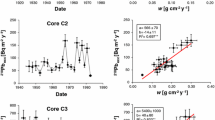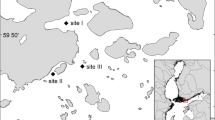Abstract
In this paper we test the utility of the mud deposition boundary depth (mud DBD) theory (Rowanet al. 1992) as a means of maximizing sampling efficiency in paleolimnological investigations, particularly those that apply to210Pb dating. The mud DBD is defined by the relationship between near bottom wave velocity and particle threshold velocity, with wave and particle threshold theory simplified to terms of exposure and depth. Mud DBD theory can be used to define the depositional zone in lakes, and within the depositional zone defined by the mud DBD: 1) there is a high probability of obtaining a representative core, 2) variation in mass sediment accumulation rate (MSAR) is not correlated with water depth, and 3) variation in MSAR is considerably reduced from the whole lake average. This suggests that mud DBD theory can account for the effects of sediment focusing, and that the mud DBD defined depositional zone is the zone to which fine-grained sediments are focused. Finally, we have shown that to optimize sampling effort, 5 to 10 cores within the depositional zone are necessary for a reasonably precise estimate of the mean mass sediment accumulation rate. In addition, the use of mud DBD theory prior to sampling can dramatically reduce the cost associated with analyzing large numbers of cores for210Pb.
Similar content being viewed by others
References
Baudo, R., 1989. Uncertainty in description of sediment chemical composition. Hydrobiologia 176/177: 441–448.
Cornett, R. J. & L. A. Chant, 1988.239,240Pu residence times in freshwaters and accumulation in shield lake sediments. Can. J. Fish. Aquat. Sci. 45: 407–415.
Cornett, R. J., L. A. Chant & B. A. Risto, 1992. Arsenic transport between water and sediments. Hydrobiologia 235/236: 533–544.
Cornett, R. J., L. A. Chant & D. Link, 1984. Sedimentation of210Pb in Laurentian Shield lakes. Wat. Pollut. Res. J. Can. 19: 97–109.
Davis, M. B., 1968. Pollen grains in lake sediments: redeposition caused by seasonal water circulation. Science 162: 769–799.
Evans, R. D., 1980. Measurement of sediment accumulation and phosphorous retention using lead-210 dating. PhD. Thesis, McGill University.
Evans, R.D. & F. H. Rigler, 1983. A test of lead-210 dating for the measurement of whole lake soft sediment accumulation. Can. J. Fish. Aquat. Sci. 40: 506–515.
Floderus, S., 1989. Sediment sampling evaluated with a new weighting function and index of reliability. Hydrobiologia 176/177: 451–464.
Foster, I. D. L., J. A. Dearing, A. Simpson, A. D. Carter & P. G. Appleby, 1985. Lake catchment based studies of erosion and denudation in the Merevale catchment, Warwickshire, U.K. Earth Surface Processes and Landforms 10: 45–68.
Håkanson, L., 1977. The influence of wind, fetch, and water depth on the distribution of sediments in Lake Vanern, Sweden. Can. J. Earth Sci. 14: 397–412.
Håkanson, L., 1981. On lake bottom dynamics — the energy-topography factor. Can. J. Earth Sci. 18: 899–909.
Håkanson, L., 1984. Sediment sampling in different aquatic environments: statistical aspect. Wat. Resour. Res. 20: 41–46.
Håkanson, L., 1992 Sediment variability. In Sediment Toxicity Assessment (ed. G. A. Burton, Jr.), Lewis Publishers, Boca Raton: 19–35.
Håkanson, L. & M. Jansson, 1983. Principles of Lake Sedimentology Springer-Verlag, Heidelberg, 316 pp.
Hermanson, M. H. & E. R. Christensen, 1991. Recent sedimentation in Lake Michigan. J. Great Lakes Res. 17: 33–50.
Hilton, J., 1985. A conceptual framework for predicting the occurrence of sediment focusing and sediment redistribution in small lakes. Limnol. Oceanogr. 30: 1131–1143.
Kimmel, B. L., 1978. An evaluation of recent sediment focusing in Castle Lake (California) using a volcanic ash layer as a stratigraphic marker. Verh. Int. Ver. Limnol. 20: 393–400.
Lehman, J. T., 1975. Reconstructing the rate of accumulation of lake sediment: the effect of sediment focusing. Quat. Res. 5: 541–550.
Likens, G. E. & M. B. Davis, 1975. Post-glacial history of Mirror Lake and its watershed in New Hampshire, USA: an initial report. Verh. Int. Ver. Limnol. 19: 982–993.
Peterman, R. M., 1990. Statistical power analysis can improve fisheries research and management. Can. J. Fish. Aquat. Sci. 47: 2–15.
Robbins, J. A. & D. N. Edgington, 1975. Determination of recent sedimentation rates in Lake Michigan using Pb-210 and Cs-137. Geochim. Cosmochim. Acta. 39: 285–304.
Robbins, J. A., J. R. Krezoski & S. C. Mozley, 1977. Radioactivity in sediments of the Great Lakes: post-depositional redistribution by deposit-feeding organisms. Earth Planet. Sci. Lett. 36: 325–333.
Rowan, D. J., J. Kalff & J. B. Rasmussen, 1992. Estimating the mud deposition boundary depth in lakes from wave theory. Can. J. Fish. Aquat. Sci. 49: 2490–2497.
Saulesleja, A., 1986. Great Lakes climatological atlas. Supply and Services Canada, Ottawa, Ont., 145 pp.
Wilkinson, L., 1989. SYSTAT: the system for statistics. SYSTAT, Inc., Evanston, II., 822 pp.
Author information
Authors and Affiliations
Additional information
This is the fifth of a series of papers to be published by this journal following the 20th anniversary of the first application of210Pb dating of take sediments. Dr P. G. Appleby is guest editing this series.
Rights and permissions
About this article
Cite this article
Rowan, D.J., Cornett, R.J., King, K. et al. Sediment focusing and210Pb dating: a new approach. J Paleolimnol 13, 107–118 (1995). https://doi.org/10.1007/BF00678101
Received:
Accepted:
Issue Date:
DOI: https://doi.org/10.1007/BF00678101




